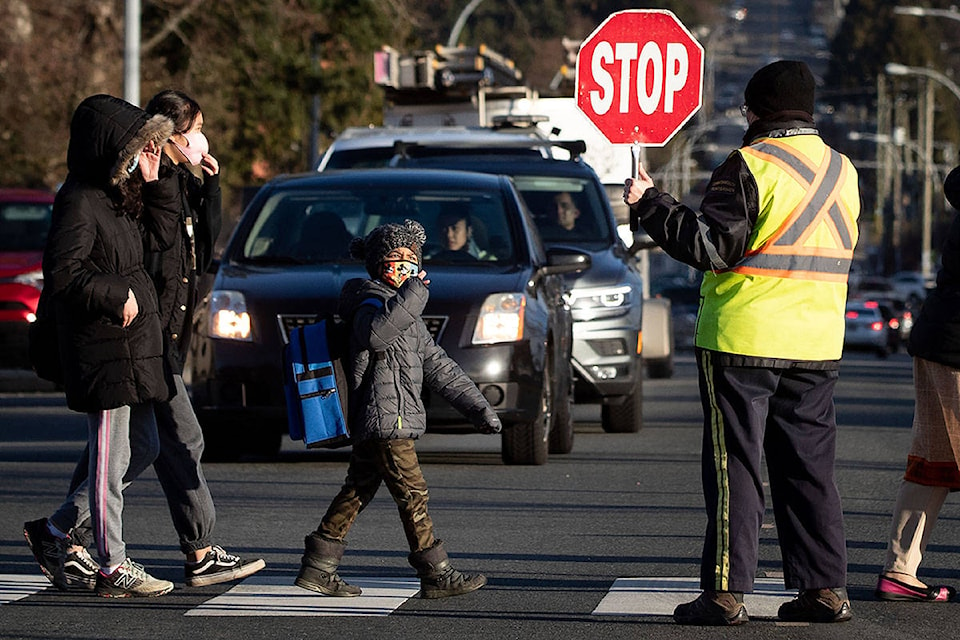Students who transmit COVID in Lower Mainland schools are spreading the virus to just one or two other children at school, a report from the B.C. government says.
In document released Thursday (April 15), data showed the province believes that the majority of cases in schools are not acquired there but simply reflect the rate of community transmission. Schools in B.C. have remained open since September, unlike jurisdictions like Ontario and Calgary that have shut them down.
Officials said that teachers and staff across the province would be immunized in the coming weeks. Teachers in Surrey have already received their vaccines.
Pre-school children make up 4.41 per cent of the population and 2.07 per cent of cases; children ages five to 12 make up 7.65 per cent of the population and 5.37 per cent of cases; teens age 13 to 18 make up 6.16 per cent of the population and 6.23 per cent of cases.
The province’s two studies look at two time periods: in Vancouver Coastal Health, the study looked at school transmissions from September until winter break in December, and in Fraser Health from January until March 7.
B.C. looked at Vancouver Coastal during the fall (before winter break) and Fraser Health during the winter (after winter break, before spring break).@BlackPressMedia #COVID19 #bced #bcpoli pic.twitter.com/z2bOeA6OY2
— Kat Slepian (@katslepian) April 15, 2021
Vancouver Coastal Health
Overall during that time period, 8,746 cases were reported in Vancouver Coastal Health. Of those about eight per cent, or 699, were students, teachers and staff. That means that of the total 124,000 students, teachers and staff in Vancouver Coastal Health, about 0.5 per cent of them were infected with COVID.
Of those cases, 77 per cent were among students while 23 per cent were among teachers and other staff.
The province’s data showed that eight per cent, or 55, of total cases were “likely acquired in school.”
Fraser Health
Overall during the time period (Jan- March 7) when Fraser Health was studied, the region reported a total of 16,053 cases. With 2,049 students, teachers and staff being infected with COVID-19, that made up about 12 per cent of total cases in Fraser Health.
Of those cases, the province said 83 per cent were among students and 17 per cent were among teachers and other staff.
Of the 2,049, about 13 per cent, or 267 cases, were “likely acquired in school.”
The province said that when transmission did take place at schools, each case would typically lead to one other case.
Data too old, teachers’ union says
While the president of the union representing B.C.’s teachers said it’s good to see some school data on COVID-19 transmission, it’s still coming months too late.
That’s according to B.C. Teachers’ Federation president Teri Mooring, who said that the Vancouver Coastal Health data paints a picture that’s not entirely helpful given the rise in variants this spring. The Fraser Health data, while more recent, still wraps up before mi-March
“It shows very little about what’s actually happening in schools in April,” she told Black Press Media by phone Thursday afternoon.
“It’s interesting to see what happened historically… we need to know what’s happened in the past couple of weeks.”
Mooring points to other jurisdictions in Canada that release data weekly, if not daily, as something she hopes to see B.C. work towards.
She said that the fact that the majority of cases in Fraser Health and Vancouver Coastal are in students points to the importance of the newest mandate that extended mask wearing down to Grade 4 students.
However, Mooring said that there has not been enough progress on the union’s main asks: clarity on when schools can or should move to hybrid learning, HEPA filters in schools and a more regional approach.
“A regional approach to a hybrid model, a regional approach perhaps, in some situations, to going to full online,” she said. That could be especially important in Fraser Health, where COVID transmission was limited to just 15 per cent of schools between January and March 7 and targeted actions could prevent a large proportion of transmission.
“We’re not talking about a province-wide hybrid model here. We’re talking about a relatively small percentage of schools – with a high population of students – that ought to have the flexibility to go to a hybrid model as necessary,” Mooring she said. “It’s a little befuddling why we can’t focus on those preventative measures in light of the data.”
READ MORE: B.C. teachers’ union asks officials for COVID data to prove schools are still safe
READ MORE: Industrial sites, pubs, restaurants driving COVID-19 spread, B.C. data show
READ MORE: B.C. urges people to stay in their neighbourhoods, discourages out-of-household meet-ups
READ MORE: Top doctor warns B.C.’s daily cases could reach 3,000 as COVID hospitalizations surge
